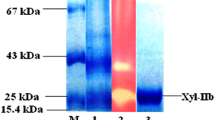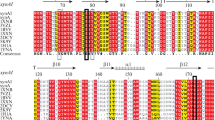Abstract
Bacillus amyloliquefaciens CH51, an isolate from cheonggukjang, Korean fermented soyfood, secretes several enzymes into culture medium. A gene encoding 19 kDa xylanase was cloned by PCR. Sequencing showed that the gene encoded a glycohydrolase family 11 xylanase and named xynA. xynAHis, xynA with additional codons for his-tag, was overexpressed in Escherichia coli BL21(DE3) using pET-26b(+). XynAHis was purified using HisTrap affinity column. Km and Vmax of XynAHis were 0.363 mg/ml and 701.1 μmol/min/mg, respectively with birchwood xylan as a substrate. The optimum pH and temperature were pH 4 and 25 °C, respectively. When xynA was introduced into Bacillus subtilis WB600, active XynA was secreted into culture medium.




Similar content being viewed by others
References
Collins T, Gerday C, Feller G (2005) Xylanases, xylanase families and extremophilic xylanases. FEMS Microbiol Rev 29:3–23
Zhang G, Mao L, Zhao Y, Xue V, Ma Y (2010) Characterization of a thermostable xylanase from an alkaliphilic Bacillus sp. Biotechnol Lett 32:1915–1920
Wong KKY, Tan LUL, Saddler JN (1988) Multiplicity of beta-1,4-xylanases in microorganisms: functions and applications. Microbiol Rev 52:305–317
Steen EJ, Kang Y, Bokinsky G, Hu Z, Schimirmer A, McClure A, del Cardayre SB, Keasling JD (2010) Microbial production of fatty-acid-derived fuels and chemicals from plant biomass. Nature 463:559–563
Wang G, Wang Y, Yang P, Luo H, Huang H, Shi P, Meng K, Yao B (2010) Molecular detection and diversity of xylanase genes in alpine tundra soil. Appl Microbiol Biotechnol 87:1383–1393
Dawn ES, Singh S, Permaul K (2009) Error-prone PCR of a fungal xylanase for improvement of its alkaline and thermal stability. FEMS Microbial Lett 293:42–47
Umemoto H, Inami IM, Yatsunami R, Fukui T, Kumasaka T, Tanaka N, Nakamura S (2009) Improvement of alkaliphily of Bacillus alkaline xylanase by introducing amino acid substitutions both on catalytic cleft and protein surface. Biosci Biotechnol Biochem 73:965–967
Zhang S, Zhang K, Chen X, Chu X, Sun F, Dong Z (2010) Five mutations in N-terminus confer thermostability on mesophilic xylanase. Biochem Biophy Res Comm 395:200–206
Kwon GH, Lee HA, Park JY, Kim JS, Lim J, Park CS, Kwon DY, Kim JH (2009) Development of a RAPD–PCR method for identification of Bacillus species isolated from chunggukjang. Int J Food Microbiol 129:282–287
Wu XC, Lee W, Tran L, Wong SL (1991) Engineering a Bacillus subtilis expression-secretion system with a strain deficient in six extracellular proteases. J Bacteriol 173:4952–4958
Jeong SJ, Kwon GH, Chun J, Kim JS, Park CS, Kwon DY, Kim JH (2007) Cloning of a fibrinolytic enzyme gene from Bacillus subtilis isolated from cheonggukjang and its expression in protease-deficient Bacillus subtilis strains. J Microbiol Biotechnol 17:1018–1023
Miller GL (1959) Use of dinitrosalicyIic acid reagent for determination of reducing sugar. Anal Chem 31:426–428
Bradford MM (1976) A rapid and sensitive method for the quantitation of microgram quantities of protein utilizing the principle of protein-dye binding. Anal Biochem 72:248–254
Laemmli UK (1970) Cleavage of structural proteins during the assembly of the head of bacteriophage T4. Nature 227:680–685
Pason P, Kyu KL, Ratanakhanokchai K (2006) Paenibacillus curdlanolyticus strain B-6 xylanolytic-cellulolytic enzyme system that degrades insoluble polysaccharides. Appl Environ Microbiol 72:2483–2490
Kim GM, Kwon GH, Lee AR, Lee KW, Park JY, Cha J, Song YS, Kim JH (2009) Characterization of a 27 kDa fibrinolytic enzyme from Bacillus amyloliquefaciens CH51 isolated from cheonggukjang. J Microbiol Biotechnol 19:997–1004
Georgiou G, Valax P (1996) Expression of correctly folded proteins in Escherichia coli. Curr Opin Biotechnol 7:190–197
Murby M, Uhlén M, Ståhl S (1996) Upstream strategies to minimize proteolytic degradation upon recombinant production in Escherichia coli. Prot Expr Purif 7:129–136
Lee CC, Kibblewhite-Accinelli RE, Smith MR, Wagschl K, Orts WJ, Wong DWS (2008) Cloning of Bacillus licheniformis xylanase gene and characterization of recombinant enzyme. Curr Microbiol 57:301–305
Shibuya H, Kaneko S, Hayashi K (2000) Enhancement of the thermostability and hydrolytic activity of xylanase by random gene shuffling. Biochem J 349:651–656
Acknowledgments
This work was supported by a grant from Ministry of Knowledge Economy, Korea. C. Baek and S. Lee were supported by BK21 program from MEST, Korea.
Author information
Authors and Affiliations
Corresponding author
Rights and permissions
About this article
Cite this article
Baek, C.U., Lee, S.G., Chung, Y.R. et al. Cloning of a Family 11 Xylanase Gene from Bacillus amyloliquefaciens CH51 Isolated from Cheonggukjang. Indian J Microbiol 52, 695–700 (2012). https://doi.org/10.1007/s12088-012-0260-4
Received:
Accepted:
Published:
Issue Date:
DOI: https://doi.org/10.1007/s12088-012-0260-4




